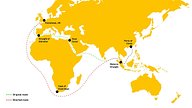The Red Sea shipping crisis has hit headlines again recently, following a series of Houthi attacks on the 163,759 deadweight tonnage M/V Sounion tanker.
Occurring late in the summer, the attack and subsequent disruption of shipping operations in the Red Sea has the potential to have more of an economic impact across the globe at a time when retailers are doubling down in the run-up to Christmas.

How Much has the Red Sea Disruption Already Affected Shipping?
There was estimated to have been 21,344 ships which crossed the Red Sea during 2023. This works out at around 59 ships using the shipping route each day, with these making up 12 per cent of global trade throughout that year.
However, defence and security think tank the Royal United Services Institute reports that just 905 cargo-carrying vessels sailed in the Red Sea in July 2024 – which is about 30 ships per day.
This is just one startling fact about the impact that the Red Sea tensions has had on the shipping industry. Integrated container logistics and supply chain services specialist Maersk has stated that the crisis has resulted in the following challenges:
- Cargo travel distances has increased by an average of nine per cent, due to vessels needing to reroute around Africa via the Cape of Good Hope to avoid the Red Sea. This has resulted in a rise in transit times, as well as more ships being required to transport the same amount of cargo.
- The above points have also caused the number of vessels being available to transport cargo to reduce considerably
In fact, Maersk estimates that available capacity had decreased by between 15 and 20 per cent during the second quarter of 2024 alone. - Another knock-on effect of ships taking a longer journey to avoid the Red Sea route is that both carriers and businesses are subjected to increased costs.
These costs are to cover the additional time, fuel and resources required to complete an extended journey.

A map displaying the usual shipping route and the diverted route
The Insights Unit of the British Chambers of Commerce has also shed light on how the Red Sea disruption has impacted businesses across the UK. According to their research, over 55 per cent of UK exporters believe they’d been impacted by the crisis. More than 53 per cent of business-to-consumer service firms and manufacturers felt the same way.
Firms surveyed pointed out that they’ve noticed increased costs – some have seen rises of 300 per cent for container hire, for example – as well as logistical delays, whereby up to three or four weeks have been added to delivery times.

It’s difficult to ignore the ongoing impact of the Red Sea crisis on our shipping operations. In response to these terrible ongoing attacks, shipping lines are understandably acting on their heightened security concerns and are continuing to reroute as a precautionary measure. We are anticipating a 2-3 week delay in container deliveries into the UK, which creates a knock-on effect for our customers.
Andrew Thompson, Chief Executive Officer of Cleveland
How Retailers Can Reduce Delays in the Lead up to Christmas
Insights by INVERTO, which is the specialist supply chain management arm of the Boston Consulting Group, has suggested that retailers across the UK have already had to alter their procurement strategies significantly in the lead up to the Christmas trading period.
INVERTO’s Principal Patrick Lepperhoff commented: "The prolonged impact of Red Sea disruptions is having knock-on effects across supply chains. Usually, the summer is a quiet time for shipping and warehousing. However, at present, the shipping industry is remarkably busy, as the complex process of getting shops stocked for the key Christmas period is moved forward by two months.
"This has put pressure on the retailers themselves as they take in more stock early, for which they may not have warehouse space. Instead, retailers will need to seek short-term storage back-up space, which can be very costly."

Block-space agreements, whereby retailers and carriers can negotiate a price for a fixed weight or volume of cargo in the future, has been recommended by INVERTO to ensure retailers have absolute clarity on available stock and upfront costs.
The company also advises retailers to:
- Set up a logistics taskforce, which will work to monitor freight rates and lead times with the aim of optimising costs.
- Look into AI solutions, which can analyse real-time rate fluctuations and conditions to identify optimal shipping routes.
- Strike up stronger relationships between suppliers and procurement, with the aim of looking into options for nearshoring so that supply chains become more resilient to risks in the future.
Maersk has echoed these recommendations, stating that businesses should invest more in data analytics and build solid partnerships in the supply chain sphere when learning from the Red Sea disruption.
They also advise retailers to look into supply chain diversification, as a business having numerous material suppliers covering various regions can help them to reduce the impact felt on any supply chain disruptions.
Need our help?
Talk to us about your container project today...
You may also be interested in...

Supply Chain Planning & Management
Discover more about the ins and outs of supply chain management systems, learning how they can help you take your business to the next level.

Why Hiring Shipping Containers is Beneficial for Your Business
Hiring shipping containers for your business instead of purchasing them outright can be a flexible and sustainable option to reduce risk and protect finances.

An Update from Cleveland on the Red Sea Crisis
We’re breaking down how the current issues in the Red Sea are affecting our business and what it means for shipping container deliveries.




0 Comment
Please leave a comment using the form below